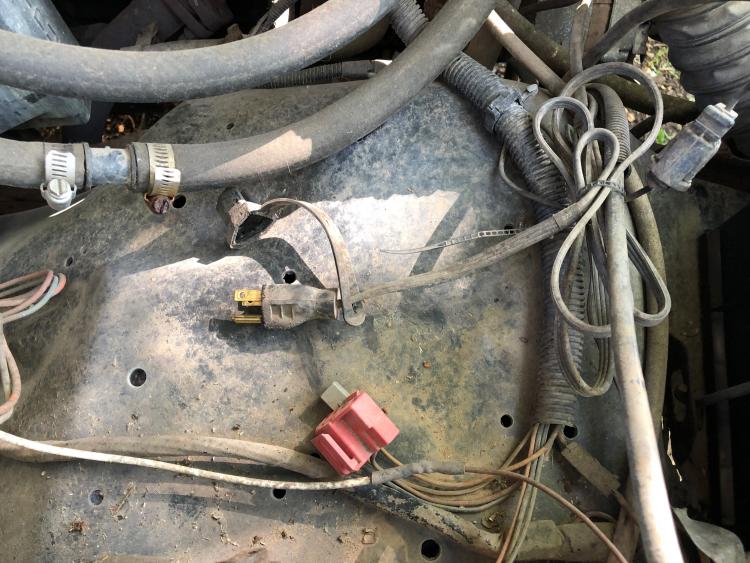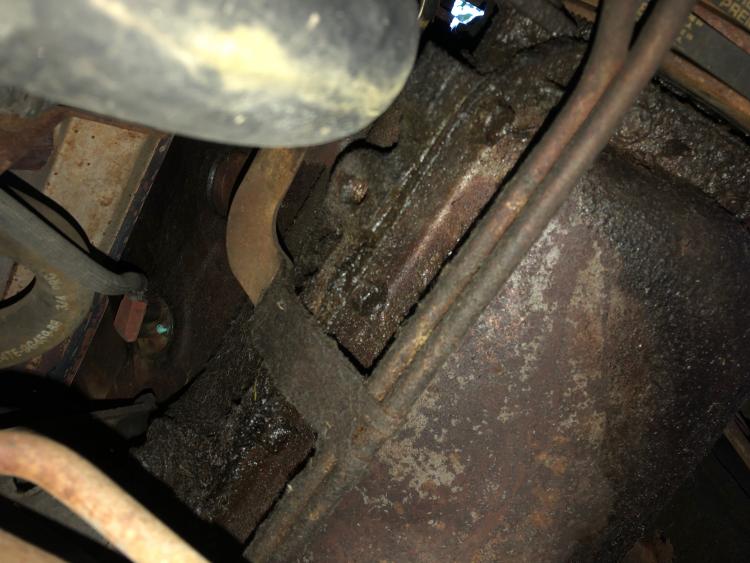Engine block heater?
|
Maybe this is obvious, but is this the plug for an engine block heater? Located in the engine compartment, passenger side.
And might be similarly obvious, but how can I figure out if it is working? Will it heat up enough overnight, during the summer (i.e. now), that I'd be able to feel the difference? 
'85 F150, I6, 4wd, 3 speed automatic
Hopkins, MN (Twin Cities) |
|
Administrator
|
It is a 110v plug, but what it powers isn't obvious. Cut that cable tie and find out where the wire goes. If it is a block heater it'll go to something that sticks into the block.
Gary, AKA "Gary fellow": Profile
Dad's: '81 F150 Ranger XLT 4x4: Down for restomod: Full-roller "stroked 351M" w/Trick Flow heads & intake, EEC-V SEFI/E4OD/3.50 gears w/Kevlar clutches
|
|
Administrator
|
Could it be ohmed to see if good?
|
|
Administrator
|
Jein. If it is a resistor, which is what a block heater would be, then a 750 watt heater would show about 20 ohms. But, if it isn't a resistor, like maybe a battery charger, then all bets are off on what the meter will show.
Gary, AKA "Gary fellow": Profile
Dad's: '81 F150 Ranger XLT 4x4: Down for restomod: Full-roller "stroked 351M" w/Trick Flow heads & intake, EEC-V SEFI/E4OD/3.50 gears w/Kevlar clutches
|
|
I don't think you need to cut the tie and being you have a six and the plug is on the right side it should be easy to look at all the freeze plugs to see if 1 has the heater in it.
It has been a L O N G time since I used a block heater on a diesel I owned to remember if you could even feel it in the winter. I even had the radiator blocked off like the big rigs do with a grille cover to help keep heat in. You can try and plug it in overnight and check in the AM if it feels warm on the block by the heater. Dave ----
Dave G.
81 F100 flare side 300 six / AA OD / NP435 / 2.75 gear http://cars.grantskingdom1.com/index.php/1980-Ford-F100?page=1 81 F100 style side 300 six/SROD parts truck -RIP http://cars.grantskingdom1.com/index.php/1981-Ford-F100 |
|
Banned User
|
In reply to this post by BigDav782
|
|
In reply to this post by FuzzFace2
I still use a block heater all the time. They heat up pretty quick...you'd be surprised. Most people (myself included) have them set on a timer to come on an hour or two before you leave in the morning. I don't think anybody south of North Dakota or Minnesota would need to keep them on all night in the winter. If you look inside one of the cheap plastic coffee kettles, they have the same style element in them. That's basically all a block heater is.
1994 F150 4x2 Flareside. 5.0 w/MAF, 4R70W, stock.
1984 F150 4X2 Flareside. Mild 302 w/ 5spd. Sold. 1980 F150 4X4 Flareside. 300i6 w/ 5spd. Sold in 2021. 1980 F100 4X2 Flareside. 351w/2bbl w/NP435. Sold in 1995 |
|
It's a block heater, and it works! Traced out the wires and when I finally looked underneath, it was pretty obvious. Plugged it in, and could feel it warming up after a couple of minutes (fairly cool outside, hadn't started the truck for a few days).
Thanks all! Dave 
'85 F150, I6, 4wd, 3 speed automatic
Hopkins, MN (Twin Cities) |
|
Administrator
|
Cool! I mean WARM!
 You may need that in a few months.
Gary, AKA "Gary fellow": Profile
Dad's: '81 F150 Ranger XLT 4x4: Down for restomod: Full-roller "stroked 351M" w/Trick Flow heads & intake, EEC-V SEFI/E4OD/3.50 gears w/Kevlar clutches
|
|
In reply to this post by BigDav782
Let there be engine warmth!
I still run a block heater on my diesel Volkswagens. ...well, we still call them block heaters, but many of the ones for Volkswagens are external, and are therefore just coolant heaters! Anyway...if I plug mine in all night when it's cold...which for me is about 10F-15F, my coolant temp in the morning will be around 150F-160F. It will actually get quite hot near the heater...like 195F, but it cools as it gets further away from it. I'd say after 30 seconds of running and everything stabilizes, the coolant temp will be right around 155F.
1994 F150 4x2 Flareside. 5.0 w/MAF, 4R70W, stock.
1984 F150 4X2 Flareside. Mild 302 w/ 5spd. Sold. 1980 F150 4X4 Flareside. 300i6 w/ 5spd. Sold in 2021. 1980 F100 4X2 Flareside. 351w/2bbl w/NP435. Sold in 1995 |
|
Administrator
|
We had them on our GM 5.7L Diesels, the first one was a 1978 and it was optional unless you lived up North, then GM released a recall instructing the dealers to install the kits for anyone who wanted it at no charge. The 1980 Bonneville had it as factory installed.
The 78 really needed it in cold weather, it had the original microprocessor controlled "slow glow" system. 8 12V glow plugs that took sometimes nearly 2 mins to turn off the "wait" light and illuminate the "start" light. In mid 78 GM started offering a "quick glow" system with 6V glow plugs and a pulse controller. Nice system, no more microprocessor, just a thermal controller, essentially the same thing Ford uses. I found a later car in a junkyard and retrofitted ours. The Bonneville had that from the beginning. I was driving it to work during one of the Steelworkers strikes as I really didn't want to drive the Chrysler convertible. I would leave it plugged in overnight and it would start right up and have heat immediately, after work it was a little slower, but not bad. They had all salaried employees and "scabs" parking in the NNS owned lots so the security guards could keep an eye on things.
Bill AKA "LOBO" Profile
"Getting old is inevitable, growing up is optional" Darth Vader 1986 F350 460 converted to MAF/SEFI, E4OD 12X3 1/2 rear brakes, traction loc 3:55 gear, 160 amp 3G alternator Wife's 2011 Flex Limited Daily Driver 2009 Flex Limited with factory tow package Project car 1986 Chrysler LeBaron convertible 2.2L Turbo II, modified A413 |
|
Administrator
|
Mine you can easily hear hissing not long after you plug it in. I listen for that to know it's working before leaving the shop.
Scott
'Camano' 1986 F250 Supercab XLT Lariat 460/C6 'Chanute' 1980 F350 C&C 400/NP 435 - Gin Pole But there ain't nothin' wrong with the radio |
|
In reply to this post by BigDav782
Another method of testing the block heater without tools is to...
Plug it into power for 5 seconds or so, then pull the plugs apart quickly. If current is being drawn by the element (block heater) then you will see a spark. This typically means the block heater is working fine. No current being drawn = no spark when pulled apart (open circuit in the heating element). Best done at night as seeing the spark in the daytime is tough sometimes. And as already mentioned above, you should see around 20-30 ohms of resistance using a multi meter and with the hood open, you can usually hear hear it (similar to plugging in a kettle).
1985 Ford F-250, 6.9L, Auto C6, 4x4 208F, Extended Cab
|
|
In reply to this post by 85lebaront2
I remember hearing about these 5.7 diesels. Aren't they kind of a bad memory?>..lol. I've never actually seen one, but I did see a truck that had a 5.7 diesel but had already had a gas engine swapped in it. 30 years ago (as a young lad) I was pumping gas at a small station, and one of the bigger GM cars came in...I can't remember what it was, but I'm thinking something like a big late 70's Delta 88? Anyway, I'm filling this thing up with gas and have a good 5 gallons in it when I happened to notice the diesel badge on the trunk lid...lol. I initially freaked out, but the owner assured me that the car had had a gas engine swapped into it. Those early 5.7 diesels were rare where I lived growing up. By the time the 6.2 diesel came out in the trucks, they were everywhere. The smaller diesels were a little more common...like the S-10 and Chevette, or the Ranger and Escort. They were all short lived, but I knew people that had all of them. The little diesel Rangers still pop up for sale every now and then.
1994 F150 4x2 Flareside. 5.0 w/MAF, 4R70W, stock.
1984 F150 4X2 Flareside. Mild 302 w/ 5spd. Sold. 1980 F150 4X4 Flareside. 300i6 w/ 5spd. Sold in 2021. 1980 F100 4X2 Flareside. 351w/2bbl w/NP435. Sold in 1995 |
|
Administrator
|
They had some issues, primarily head bolts and gaskets. The firing order was the pretty standard 18436572 which if you use the Ford cylinder numbering comes out 15426378. The problem area was between cylinders 5 & 7 the load on the head bolts between those two cylinders was unreal, and they have 10 1/2-13 bolts. There were a couple of gasket updates, a redesigned head, improved bolts during the production run.
Once I put the 1983 engine (from a wrecked Eldorado) in and did some other updates, the car was pretty reliable and once I added a lockup converter transmission would consistently deliver 30-31 mpg highway. The Rossamaster injection pumps had issues too, the governor weight retainer ring was a piece of soft plastic, that after a few years hardened and crumbled, clogging the return fitting on the pump cover. This would cause extremely poor running if at all. When we first got the car it's fuel economy and performance were pretty bad, 12-14 in town and 18-20 highway, worse that our 1970 1/2 Falcon wagon. I found the Roosamaster internal timing mark after 6 trips to the dealer to resolve the issues, culminating in the service manager telling me they really had no solution and since I was trained on Diesels, to let them know if I figured it out. Using a piece of vacuum hose to lock the rotating portion of the pump at TDC, I put it back on the adapter and pulled it against the gear train and marked the adapter. After returning the pump to normal operation, and reassembling everything when I started the car , it sounded different, a more normal Diesel clatter. Fuel economy and performance went up sharply. End of story, about 2 weeks later I received a call from the service manager, he had a copy of a TSB from Oldsmobile regarding improperly marked pump adapters and would I like to schedule a day to have this done on ours. When the tech went through the procedure with the tool GM provided, my mark was dead on where it should be. Once the bulk of the bugs were resolved it was a pretty reliable car. The Bonneville that replaced it had been a beneficiary of the 5 year 50,000 mile extended warranty on these engines, ours had too many miles the first time the head gaskets went. I got extremely proficient at changing head gaskets and rebuilding Roosamaster pumps (also used on GM 6.2/6.5L diesels and Ford 6.9/7.3 IDI engines). Somewhere, I think I still have the Roosamaster service manual as there were a number of people who I worked with at NNS, we called ourselves the Diesel Underground.
Bill AKA "LOBO" Profile
"Getting old is inevitable, growing up is optional" Darth Vader 1986 F350 460 converted to MAF/SEFI, E4OD 12X3 1/2 rear brakes, traction loc 3:55 gear, 160 amp 3G alternator Wife's 2011 Flex Limited Daily Driver 2009 Flex Limited with factory tow package Project car 1986 Chrysler LeBaron convertible 2.2L Turbo II, modified A413 |
| Edit this page |


